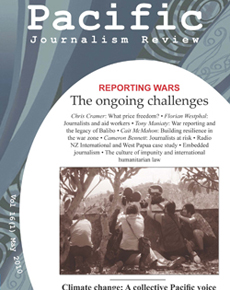Editors, journalists face challenge of ‘price of freedom’ in latest PJR

Editors, journalists and media researchers face the challenge of the “price of freedom” and the cost of reporting global conflict in the latest edition of Pacific Journalism Review.
Writing in the edition, Shooting Balibo author Tony Maniaty, who was a consultant for the recent film on the killing of six Australian-based journalists – including a New Zealander – in East Timor, makes a strong plea for wider acceptance of international humanitarian laws.
“As a first move ... we need to stop viewing and presenting war as an heroic enterprise, and see it for what it fundamentally is – an inhuman, horrific and desperate act by people devoid of imagination, for whom brute force is not the last resort, but usually the first,” he says.
Maniaty, of the Australian Centre for Independent Journalism (ACIJ), is a guest speaker at a war reporting seminar being organised by the International Committee of the Red Cross and the New Zealand Red Cross in partnership with AUT University and its Pacific Media Centre (PMC) on May 24.
The special edition of the journal, published by the PMC, highlights the new Australian code to protect the safety of journalists and notes the lack of an equivalent in New Zealand media.
The edition will be launched at the seminar, which will include a screening of the film Balibo and a debate about the cutting edge of journalists’ safety in war zones by leading war correspondents TV3’s Mike McRoberts, TVNZ’s Sunday current affairs programme presenter Cameron Bennett and independent journalist Jon Stephenson.
Both Bennett and Stephenson have commentaries featured in the journal, which has published a series of papers from war reporting conferences hosted by the Australian Broadcasting Corporation and the ACIJ in Sydney, and Massey University in Wellington, in May last year.
New York-based Reuters global multimedia editor Chris Cramer writes on the “challenges to journalists’ safety and welfare” and has recorded a video message for the Auckland seminar.
“Is the industry in such a mess, in such chaos and crisis, that fair and balanced reporting from conflict zones, as well as other locations, is simply too expensive for much of the industry to bear?” he asks in PJR.
“Who does the reporting when reporters can’t afford to get on an aircraft? Even drive a few hundred kilometres to cover the story? What price a free press if our business models can’t sustain our work?”
Contributors to the edition include journalists on both sides of the Tasman, media educators, lawyers, Red Cross figures, war correspondent trainers and military media minders.
Other unthemed research articles published include political blogs on Fiji – a ‘cybernet democracy’ case study, local news in community broadcasting and an analysis of Pacific Island nations’ climate change strategies at Copenhagen 15.
Editors of this edition are Professor Wendy Bacon of the ACIJ, PMC director Dr David Robie and Alan Samson of Massey University. Copies of the Pacific Journalism Review can be ordered from the Pacific Journalism Review website.
Pacific Media Centre | AUT University | pmcentre@aut.ac.nz | Tel: +649 921 9388